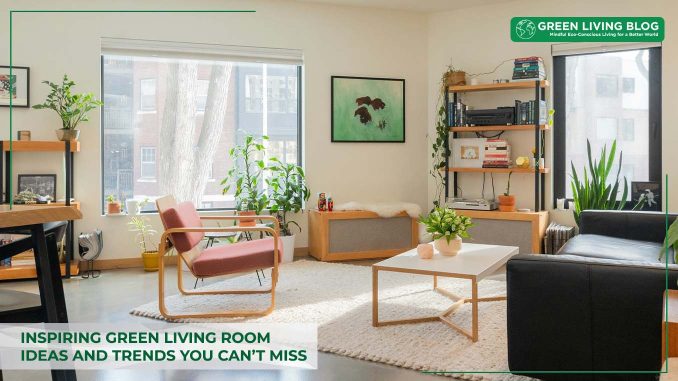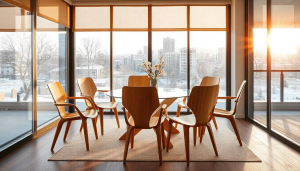
Looking for some inspiration on how to decarbonise your living quarters and give your home’s decor an eco-friendly overhaul?
You’ve come to the right place.
Our guide to green living is bursting with ideas on how you can shop sustainably and still furnish your living room stylishly.
We have all aspects of your living room’s decor covered – from furniture and flooring to paints and plants.
Finally, we know technology has an important role to play in helping curb carbon emissions.
That’s why our list features some must-have gizmos that will allow you to monitor and control the energy you use to heat your home.
1. Utilise Reclaimed Wood for Furniture

If you’re going with wood for your furniture, you need to make sure it comes from a sustainable source – ideally, it should be fashioned from a piece of handsome reclaimed wood.
As a rule of thumb, if you’re looking to source your furniture from a sustainable source, go for wood that’s been given the seal of approval by the Forest Stewardship Council (FSC).
Reclaimed wood is not only good for the environment, it also makes super-stylish furniture.
It’s full of character and brimming with history – every bump, knot, notch and grain has a story to tell about its past.
Reclaimed Wood’s Carbon Saving
- By using reclaimed wood, you save around 1.5 tons of CO₂ compared to freshly harvested wood.
- Reclaimed wood also allows us to eliminate the emissions from logging and can reduce the energy consumption used to make your furniture to the tune of 30–50%.
Where to Buy
- James² Bespoke Furniture Store: A family-run company founded by two brothers who are passionate about woodworking and furniture design using reclaimed wood. https://www.james2.co.uk/
- Markham Reclaimed: Specialise in made-to-order furniture, offering custom sizes, finishes and designs. https://www.markhamreclaimed.co.uk/
- Shabby Bear Cottage: All the company’s reclaimed wood furniture is handcrafted in its Devonshire workshop. https://www.shabbybearcottage.co.uk/
2. Implement Sustainable Cork Flooring

When it comes to flooring, look no further than cork, a brilliant, bouncy and beautiful alternative to hardwood flooring.
Cork is an ideal material for flooring because it’s a highly durable, hard-wearing stuff – at once both soft and durable, it’s a pleasure to walk and also serves as a good insulator to boot.
Cork’s sustainability comes from the fact the tree isn’t felled to produce the wood.
Instead, the tree’s bark is stripped, which will eventually replenish and regrow. A typical cork tree can live upwards of 200 years, and its bark can be harvested every decade or so.
Furthermore, harvesting the cork has other green benefits.
The cork oak tree has a remarkable capacity to absorb the carbon we spew out – for each kilogram of cork produced, the tree captures an extra 73 kg of CO₂ than it otherwise would.
And if that weren’t all, cork is also biodegradable, recyclable, and repurposable – so once it has reached the end of its useful life at your place, it can live on in someone else’s.
Cork is a Carbon Sink
- The Mediterranean cork forests found in Portugal and Spain – which account for much of the cork used in flooring – act as a carbon sink for 14 million tons of European CO₂.
Where to Buy Cork Flooring
- Puretree Cork: The UK’s largest stockist of cork; provides bespoke cork flooring. https://www.puretreecork.co
- The Colour Flooring Company: Handpicks high-end, high-spec modern cork flooring. https://www.colourflooring.co.uk/.
- Beach Bros: The UK’s largest importer and distributor of cork flooring. Partners with manufacturers like Amorim and Wicanders. https://www.beachbros.co.uk/
3. Get more Air-purifying & Dehumidifying Plants

By bringing some nature indoors, you do two things: you remind yourself of your connection with the natural world, and you do your bit for the environment by cleaning and dehumidifying the air in your rooms.
Worryingly, according to the people at NASA, the air indoors can be as much as 30x more toxic than that found outdoors.
By putting a few plants in your living room, you can remove nasties such as formaldehyde from your interior air.
Succulents and cacti will purify your air and also work well as natural dehumidifiers, as they love to draw in excess moisture from the atmosphere.
Cacti are especially good if you’re looking to introduce some greenery into a small living room, as they are compact and tend to grow in the vertical direction, so they won’t impinge on your living space.
The right mix of dehumidifying and air-purifying plants should allow you to cut down on your use of electric dehumidification and air purifiers.
Absorbing Facts
- Tillandsia (Air Plants): A super-absorptive piece of greenery that can take in up to 5-10% of its weight in atmospheric water each day.
- Areca Palm (Dypsis lutescens): Another big absorber of ambient moisture, trapping up to 100 mL per day.
- Reed Palm (Chamaedorea): Absorbs up to 100 mL per day.
- Cactus (Cactaceae): Hardy plant that requires little care and can absorb around 1-5 mL of water per day.
Where to Buy
- Love Tillys has put together an Air Plant Beginners Collection, a perfect plant starter kit.
- The Opuntia microdasys or bunny-eared cactus available at Melanie’s Florist is fun, decorative and low maintenance.
- Oxy Plant’s Areca palm sports rich foliage and has proven air-purifying properties.
4. Give Steam-Bent Furniture a Go

Steam-bent furniture goes back to the early days of mass-produced moveables.
It has recently had something of a renaissance as eco-conscious buyers have recognised it as an eco-friendly alternative to mass-produced pieces, which are produced using dirty fossil fuels.
Steam bending is a handcraft technique that can be used to fashion all types of eco-friendly furniture – from tables and benches to armchairs and footstools.
By buying a piece of steam-bent furniture for your living room, you’re also buying something unique – because the steam-bending process is carried out entirely by hand, no two pieces of furniture are the same.
Beautiful species of wood – ash, oak, cherry, birch and maple – lend themselves to steam bending and produce lovely living room pieces.
For maximum eco-friendliness, opt for steam-bent wood that has been air-dried during the finishing stage, which gives an added layer of eco-friendliness to your finished piece because it doesn’t use fossil-fuelled dryers to finish the furniture.
Where to Buy
- Tom Raffield: Based in Cornwall, Raffield specialises in steam-bent lighting fixtures and furniture. https://www.tomraffield.com
- Steamed Studio: Combines modern designs with traditional steam-bending techniques. They make first-rate mirrors, ceiling light fixtures and table lamps. https://steamedstudio.co.uk
- Angus Ross: Sources its wood for steam bending from local Perthshire timber. Ross made his name designing steam-bent chairs, so if you’re looking for somewhere sinuous to sit, check them out. thttps://www.angusross.co.uk
5. Give Seagrass & Sustainable Cotton a Chance

When it comes to the upholstery in your green living space, you should go for sustainable fibres.
Two of the best are seagrass and sustainable cotton.
If you opt for the latter, go for GOTS-certified (Global Organic Textile Standard) cotton.
Seagrass is ideal for rugs, carpets, baskets, lampshades and placemats.
It’s hard wearing, durable and non-porous, which means it’s a naturally stain-resistant material.
Top Picks: Sustainable Cotton
- Home of Juniper: Large Dove Herringbone GOTS Cotton Blanket.
- Ferm Living: Living Pose Cushion – Coffee/Undyed.
- Kiota: Organic Cotton White and Beige Checkerboard Rug.
Top Picks: Seagrass
- Richard Wylie: Plains Earth Seagrass – Abraham Moon fabric.
- West Elm: Handwoven seagrass basket.
- Natural Rug Company: Seagrass rug with Herringbone border.
6. Use Eco-Friendly Paints for your Walls

Use low-VOC (Volatile Organic Compound) or zero-VOC paints to minimise indoor air pollution.
These types of paints are also generally more sustainable than the chemical-heavy alternatives.
Traditional VOC-based paints release harmful chemicals (formaldehyde, benzene, and toluene) into the air when they’re applied and during the drying process, which can last up to a month in some cases.
VOCs are not only associated with a host of health-related issues – exposure to them can cause dizziness, headaches and even cancer – but they are also harmful to the environment.
On the other hand, Low-VOC paints improve the air quality indoors and benefit the environment because they don’t release nitrogen oxides into the air, a cause of ground-level ozone and smog.
Where to Buy VOC Paints
- Tikkurila offers a range of colourful water-based paints that are low-VOC. https://www.tikkurila.co.uk/
- Organic Natural Paint supplies VOC-free Graphenstone, Auro, and Earthborn paint https://organicnaturalpaint.co.uk/
- Little Knights supplies independently tested and verified 100% VOC-free paint. https://www.little-knights.co.uk/
7. Incorporate eco-friendly Clay Plaster Walls

Clay plaster walls are very fashionable at the moment, thanks to the visual appeal of the natural substance and clay’s eco-friendly credentials.
Clay comes in many colours and is very malleable, giving it a host of textures and feels. This means it has an eye-catching and unusual visual appeal when daubed on the living room walls.
It‘s ideal for accent walls – modern Venetian-style plaster mixtures such as Grassello, Stucco and Marmorino add a stunning visual effect that draws the eye by adding depth, pattern and aesthetically pleasing smoothness to a wall that will wow your guests.
Because it’s sourced from the earth’s crust, clay is an eminently sustainable substance, and the production process doesn’t produce the carbon that clay alternatives such as cement and gypsum do.
Plus, it will work in concert with your dehumidifying and air-purifying plants – it doesn’t produce those noxious VOCs, and its natural absorptivity will draw moisture from the air, dehumidifying your rooms.
Clay Versus the Competition
- The production of cement plaster releases 6–0.9 kg of CO₂ per kg of cement used in the mixture.
- Heating gypsum plaster in kilns releases 25–0.35 kg of CO₂ per kg of gypsum.
- Conversely, clay plaster requires minimal processing – it emits almost zero CO₂ during production.
Where to Buy
- Clayworks: The company’s clay, manufactured in Cornwall, is among the most low-carbon you’ll find. www.clay-works.com
- Mike Wye & Associates – Specialises in multi-coloured YOSIMA clay plasters. www.mikewye.co.uk
- Evoke Polished Plastering: Its Duro clay plaster gives walls a subtle shimmer and has natural anti-fungal properties. www.evokepolishedplastering.co.uk
- Luna Plaster: The company’s Earth Plaster, a 100% natural blend of unfired clay mixed with minerals and pigments, gives walls a healthy, breathable finish. www.lunaplaster.co.uk
- EarthCoat: Offers eco-friendly, non-toxic natural clay plasters. earthcoat.co.uk
8. Use Smart Thermostats

A smart thermostat is not only good for the environment – it’s good for the pocket, too.
This little device allows us to track and reduce consumption and set schedules for our energy use.
The most advanced kit – Google Nest Learning, for example – comes with AI smarts that allow it to learn our preferences and routines, and many are now Matter-compatible, which brings an extra layer of interoperability to smart devices, including thermostats.
So it will cook up a heating and cooling schedule with little human input and have your living room toasty when you come home from work.
Some smart thermostats also come with nice-to-haves, such as open window detection, which shuts the system down if it detects you’ve left a window open and the heat is escaping.
Why Matter Matters
Matter is an industry-standard developed by a coterie of tech companies to standardise the smart tech in our homes.
Led by Apple, Google, Amazon, and Samsung, it aims to facilitate better, more secure, and more reliable smart cloud-based devices such as smart thermostats.
The standard has yet to take off in the UK, but we can expect it to do so soon as eco-friendly customers look for smart energy-saving tech that can communicate seamlessly with other bits of smart tech in their homes.
Where to Buy Smart Thermostats
- Google Nest Learning Thermostat (3rd Generation)
This thermostat learns your schedule to create a personalised heating plan, enhancing comfort and energy efficiency. It features a sleek, circular design and integrates seamlessly with other Google Home devices.
Buy here: https://store.google.com/gb/product/nest_learning_thermostat_3rd_gen. - Hive Active Heating Thermostat: Remotely control your heating via a user-friendly app. Compatible with Amazon Alexa and Google Assistant. It includes features such as frost protection and holiday mode, which allows you to prevent frozen pipes and save energy while you’re away.
Buy here: https://www.hivehome.com/products/hive-thermostat. - tado° Smart Thermostat V3+: Provides multi-room control and is one of the first Matter-compatible thermostats available in the UK. It integrates with a host of smart home systems, including Apple HomeKit, Amazon Alexa, and Google Assistant.
Buy here: https://www.tado.com/gb-en/smart-thermostat. - Honeywell Evohome Thermostat: The perfect device if you’re looking to keep on top of your energy use in a large house, as it gives you control of the heating in up to a dozen zones. It also allows you to control underfloor heating and can be controlled via a touchscreen interface, a remote control or a smart app.
Buy here: https://heatingcontrols.honeywellhome.com/evohome. - Drayton Wiser Smart Thermostat: A budget smart thermostat that features multizone heating if used in concert with smart radiator thermostats. It’s compatible with both Amazon Alexa and Google Assistant and offers a handy suite of tools and functions, including open window detection.
Buy here: https://wiser.draytoncontrols.co.uk/.
9. Put up PET Blinds & Thermal Curtains

Almost ten million tonnes of waste plastic, often in the form of disposable drinking bottles, is dumped in the world’s seas and oceans each year.
It’s therefore urgent that we find a way of reusing and repurposing this plastic so it doesn’t clog up our beautiful bodies of water.
One way of putting this waste to work is by breaking it down and spinning the yarn into window blinds for your eco-friendly living room.
Add thermal curtains to the mix, and not only will you have a window covering that’s eco-friendly, but you will also add an extra layer of insulation to your living space, keeping heat in and energy bills down.
Top Picks: PET Blinds
- Stitched’s The Conservationist roller blind is made from 100% recycled plastic from the bottom of the Mediterranean.
- Luxaflex’s Roller Blinds and Vertical Blinds are made with GreenScreen Sea-Tex fabrics, fashioned from plastic recovered from the shoreline.
- Unbeatable Blind’s eco-friendly vertical blind and vertical roller blind are both made from PET materials.
10. Only buy Beeswax Candles

Everyone likes a fresh-smelling house, especially a fragrant living room.
Unfortunately, many of the mass-produced air fresheners and fragrances we spray to kill bad odours and make our living rooms fragrant are harmful to both the environment and our health.
That’s because they often contain those nasty VOCs we mentioned earlier.
A natural and healthier alternative is a beeswax-based fragrance, an eco-friendly alternative to VOC-laden air fresheners.
When burned in the form of a candle, natural beeswax gives off a subtle and sweet honeyed aroma.
Burning beeswax also produces negative ions, which, by producing a static charge around airborne nasties, act to purify your air by dragging the contaminant to the nearest surface.
Top Picks: Beeswax Candles
- Northumberland Honey Churchill Candle: A heavy-duty church candle that burns for up to 120 hours.
- Chainbridge Honey 100% Beeswax Egg Candles (Pack of 4): A quirky and decorative multipack of egg-shaped candles.
- Kame’s Farm Long Beeswax Candle: A highly decorative beeswax candle with an attractive honeycomb aesthetic.
Go Green, Never Go Back
Hopefully, our list of 10 green living room ideas has given you some inspiration as you go about making your living room greener and eco-friendlier.
We know it’s not easy deciding how best to go about creating a more sustainable living room environment, especially if you’re on a budget.
But many of our ideas involve making small, affordable green changes that will start you down the road to more sustainable living.
Others – like smart thermostat gizmos – might entail some outlay but will pay for themselves in the long run by allowing you to make more efficient use of your energy.
![]()
Author Profile
- Passionate content creator, contributor, freelance writer and content marketing allrounder.
Latest entries
 Best practicesApril 12, 2025Top 6 Eco-Friendly Choices for Sustainable Living in Your Everyday Life
Best practicesApril 12, 2025Top 6 Eco-Friendly Choices for Sustainable Living in Your Everyday Life BusinessMarch 31, 2025How to furnish your Office with sustainable Cardboard Furniture
BusinessMarch 31, 2025How to furnish your Office with sustainable Cardboard Furniture Best practicesMarch 21, 202511 Practical Ways to Limit Your Exposure to Microplastic Pollution
Best practicesMarch 21, 202511 Practical Ways to Limit Your Exposure to Microplastic Pollution EnvironmentFebruary 27, 2025What is Asbestos and Who Does it Impact?
EnvironmentFebruary 27, 2025What is Asbestos and Who Does it Impact?






Leave a Reply
You must be logged in to post a comment.